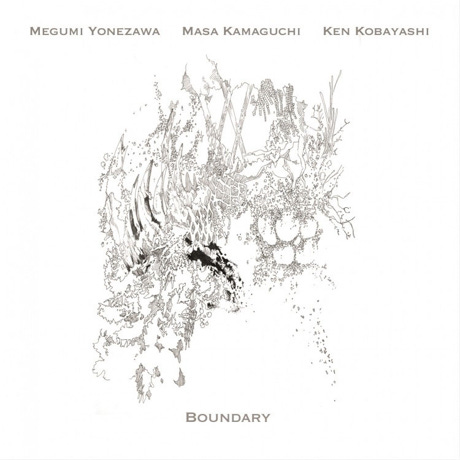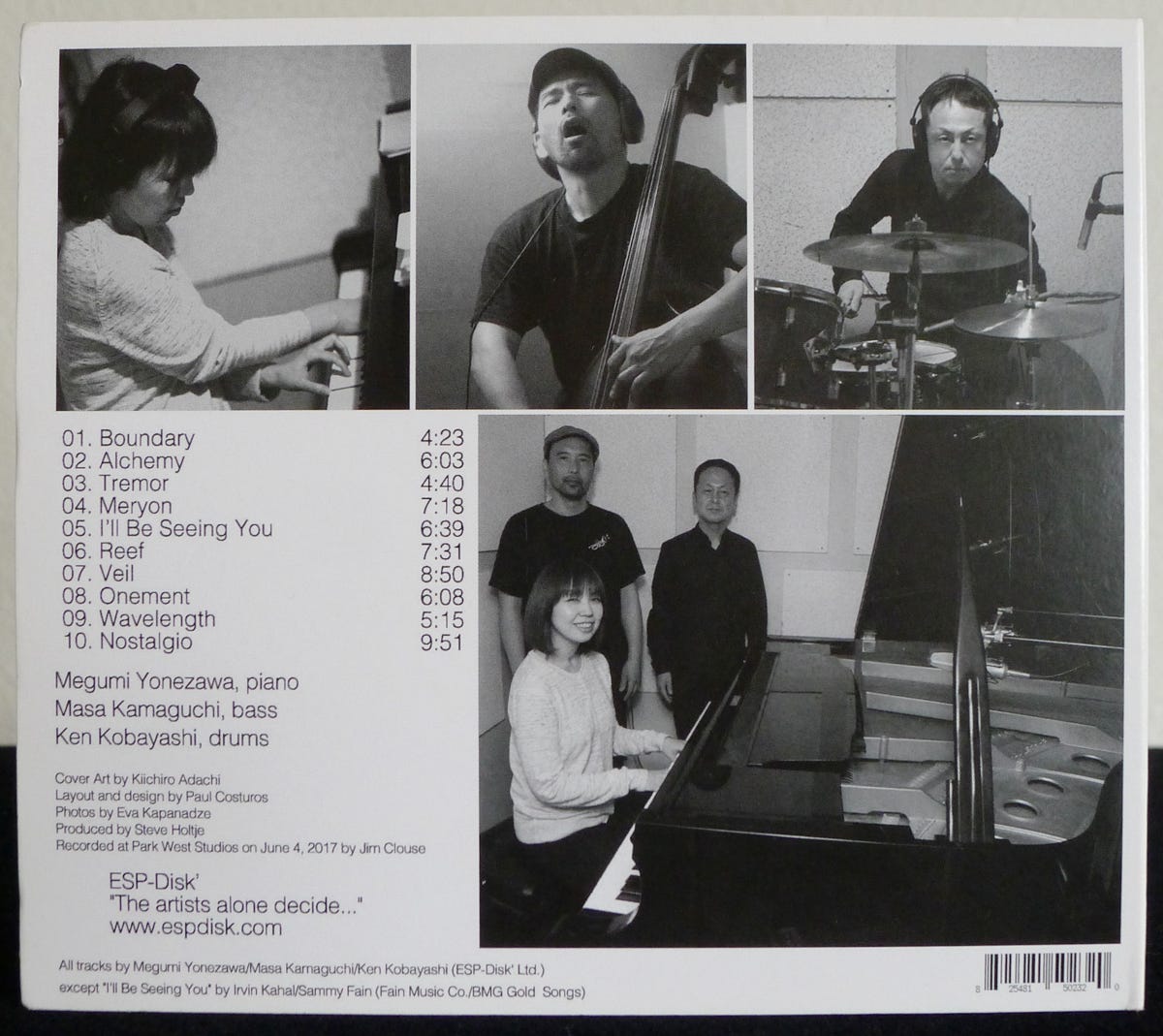Megumi Yonezawa / Masa Kamaguchi / Ken Kobayashi: Boundary
Boundary is the 2018 release from the trio of pianist Megumi Yonezawa, bassist Masa Kamaguchi, and drummer Ken Kobayashi. This album is the result of a suddenly booked recording session in Brooklyn while bassist Kamaguchi was temporarily in town and playing with the New York-resident pianist and drummer. Their live performance inspired a producer to arrange a trio recording while the opportunity was available.
Open and experimental, the music on the album is 66 minutes of improvisation. The songs are a loosely-structured dialogue between the three members as they play freely using prompts and suggestions to one another, responding in the moment to what they are hearing from others and imagining within themselves.
Most of the ten tracks are original songs which, in the spirit of free jazz, may have been unrehearsed sketches explored (or completely improvised) for the first time in the studio. The intuition of the musicians through their ears and experience guides them to create music that is abstract but not formless. There are sounds and structures that color outside of the lines, but that are controlled musically and not overly chaotic.
The music flows like untethered explorations in space as the three members seek to coordinate and unite their musical impulses, feelings, and thoughts into unified musical ideas from track to track, or within each track as the moments strike and ideas take shape. It’s liberating and fascinating to listen to, and ceding control to the music and allowing it to lead is a good idea. As the music avoids mainstream patterns, some jazz fans may find this music challenging and it may not be for everyone. Although, what is?
Similarly, it also must also be challenging for experienced jazz musicians such as these to determinedly avoid the common movements and phrases that rise, like habits, unbidden to their minds and fingers and which must be suppressed in service of the freedom that their music is pointed towards.
A trek through the tracks describes the album’s moods, as abstract and spontaneous as those might be. The music starts with the opener #1 “Boundary”, which seems to play with the idea of reaching a point of allowed travel, a limit, and seeing what happens when that edge is crossed or examined up close. Notes travel like a mosaic of crazed glass with small fragments of chaos to provide an indication of things to come, and the boundary is crossed from a safe location towards an energized and possibly dangerous adventure.
Next, #2 “Alchemy” bubbles with increased entropy and the stress of a chemical reaction. The more easily identifiable licks and rhythms of #3 “Tremor” provide the hooks of a sudden jazz-like jam with a sense of forward movement.
#4 “Meryon” is as moody as the monochromatic etchings of the French artist Charles Méryon’s views of old Paris, perhaps tracking his descent into madness through the eerie metamorphosis of the song as it builds and disassembles.
In the track listing, the one standard tune included is #5 “I’ll Be Seeing You”. Here, heartfelt piano floats wistfully along as rolling waves of brushed snare and cymbals maintain a sense of underlying tension, and more bittersweet pain is extracted from the popular song than is usually heard.
The second half of the album continues developing the trio’s improvised ideas and themes. #6 “Reef” introduces beeps, boops, and rumbles that assemble into structures. #7 “Veil” features a sparse piano and bass duo with more-felt-than-heard drumming that reveals pretty views through slow snatches of melody and subtle clues.
#8 “Onement” is based on a single clipped note repeating like an alarm as an automated factory wakes up and initiates its slapstick assembly processes like a strange Looney Tunes scene. #9 “Wavelength” is a bass and drums improvisation that boils ambiently over a fire that threatens to get out of control.
Finally, #10 “Nostalgio” brings the volume and temperature down as notes drop, disperse, and uncover a peaceful ballad in the ripples. That is, the unlisted standard “I Loves You, Porgy” fills the second half of this final track. This tender standard emerges to complete the album with an unfiltered return to standard form for a beautiful dénouement, transporting us back across the boundary, slowly and safely home.
Liner Notes
(Reproduced from the album liner notes written by Matthew Shipp)
Is space the next frontier? Well, it's so beautiful and refreshing to hear a piano trio that is secure enough in itself to utilize space in a relaxed manner and paint their portrait in sound in an assured, inspired way with a balance and equilibrium that allows the listener the psychic space to take it all in, let it find its level in one's own inner world. Individual musical devices and events are isolated—a dialogue always exists between the right and left hands of the pianist—on top of the dialogue that exists between the members of this wonderful trio. This trio sounds like they were destined to play together since time began, and the exploration is always allowed to unfold in a manner that is natural for whatever compositional event was isolated in the improvisation and is unfolding.
This trio always sounds natural—it is an overall concept here that informs the whole trio and generates the resultant music—and the overall concept generates the interaction between trio members and the overall beauty of the sound contained here. This fits in very well with the ESP-Disk' piano tradition, though this CD is its own world within itself. It sits really nice next to Paul Bley and Lowell Davidson, though the pianist has her own distinct sense of phrasing with its own type of internal swing and projection of piano sound. This CD fits in well in the ESP tradition of CDs that Gary Peacock played bass on, though again there is nothing here that sounds exactly like Peacock—it is a spirit I am talking about that informs the music. Any other bassist in this particular trio could have forced the music in a more traditional sound—this bassist seems to be the perfect complement among the pianist and the drummer to let the music breathe and find its own space. The drummer not only holds everything together and keeps things moving but has a way about him that encourages everyone to think in dialogue. The couple standards here help elucidate the way this trio goes about its business—and will give you a glimpse into how they conceptualize the idea of already given form and freedom. Exploring standards with freedom has become a thing in a lot of new music, and it both illustrates the continuity between the language while giving certain listeners something to hold on to, the challenge of course being whether you can take the traditional material, use it as camouflage, and make it sound natural within your own language. Yes, it can become a language game to some extent.
This is not a traditional free jazz CD—and it is obviously not a straight-ahead jazz CD. It is also not an attempt to meld the two together. It is not anyone showing off their chops. Also, no one sounds like they are trying to prove anything. What is so beautiful about this CD is that it is really, really honest. Really. This trio knows music but is open to throwing their preconceptions out and seeing where things go. This is an honest statement. Sit back and enjoy the ride. — Matthew Shipp
Boundary by Megumi Yonezawa / Masa Kamaguchi / Ken Kobayashi
Megumi Yonezawa - piano
Masa Kamaguchi - bass
Ken Kobayashi - drums
Released in 2018 on ESP-Disk' as ESP-5023
Japanese names: Megumi Yonezawa 米澤めぐみ (Yonezawa Megumi) Masa Kamaguchi マサ・カマグチ (Kamaguchi Masa) Ken Kobayashi 小林健 (Kobayashi Ken)
Links
Audio and Video
Excerpt from “Nostalgio”, track #10 on this album:






